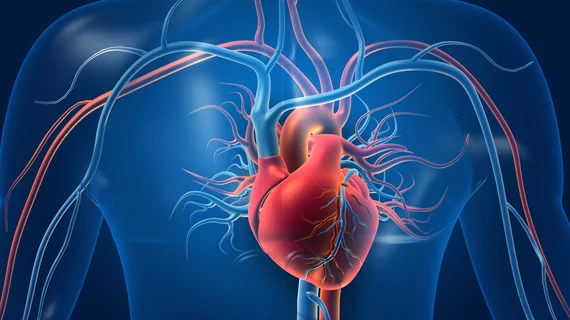Cardiac MRI findings can predict incident CVD years before onset
MRI findings in middle-aged adults without known cardiovascular disease were found to be associated with incident CVD, researchers recently reported in Radiology.
The research focused on 1,513 participants of the Framingham Heart Study Offspring Cohort, none of whom had been previously diagnosed with prevalent CVD. Prior cardiac MRI scans of the descending thoracic and abdominal aorta in these participants revealed thoracic aortic wall area (AWA), plaque prevalence and plaque volumes to be independently associated with incident CVD on later follow-up visits (median, 13.1 years).
“Clinically overt vascular disease is preceded by a long subclinical phase characterized by widespread arterial wall thickening and plaque formation, two processes that may be pathophysiologically distinct,” corresponding author Connie W. Tsao, from the Department of Medicine, Cardiovascular Division at Beth Israel Deaconess Medical Center, and co-authors explained. “Measurements of subclinical vascular damage, including arterial plaque, merit consideration in CVD risk assessment.”
Using the prior MRI scans, researchers calculated AWA by measuring the wall thickness of the thoracic aorta at the pulmonary bifurcation level. Patients’ electronic medical records were analyzed for incident CVD events or stroke and coronary heart disease, and then compared to their AWA as calculated on prior MRIs.
CVD events occurred in 223 of the participants on follow-up, of which 97 were considered major (myocardial infarction, ischemic stroke, or CVD death). In these patients, AWA and presence of thoracic plaque were found to be associated with incident CVD, a one-third increased risk for stroke and twofold increased risk of coronary heart disease.
“Earlier diagnosis and treatment of atherosclerosis in the preclinical stage may reduce occurrence of overt CVD. We observed a strong association of AWA with hypertension and stroke, implying that elevated AWA may warrant more aggressive management of blood pressure,” the authors wrote.
They went on to explain that since these measurements are easily reproducible, they can be assessed during routine cardiac MRI exams completed for a variety of clinical indications. This could be used as a tool to detect the warning signs of CVD before it becomes prevalent and prompt preventative measures earlier, the authors suggested.
Read the full study here.
Related cardiac MRI articles:
Water-fat separation sequence yields superior image quality compared to standard coronary MRA
AI carries ‘enormous potential’ to transform cardiac MRI, reduce scan times without using contrast
AI analyzes cardiac MRI blood flow to predict stroke, heart attack, death
New cardiac MRI analysis offers updated insight into long-term impact of vaccine-related myocarditis

